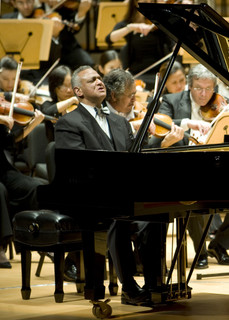|
Back
Gravitas et grandiloquence Orange County
Renée and Henry Segerstrom Concert Hall
06/02/2016 - & 3, 4 June 2016
Ludwig von Beethoven: Piano Concerto N° 4 in G major, Opus 58
Hector Berlioz: Symphonie fantastique, Opus 14
André Watts (Piano)
Raymond Kobler (Concertmaster), Pacific Symphony, Carl St. Clair (Conductor) 
A. Watts (© Steve J. Sherman)
Positioned with 26 years as Pacific Symphony’s Music Director, Carl St. Clair can find comfort in knowing his 2015-2106 season is coming to a close in a most memorable way. One of the longest tenured conductors in America, time has been kind to Maestro St. Clair and the opportunity to foster close relationships with showcase artists. Last night was no exception with returning perennial favorite, André Watts. Within weeks of achieving septuagenarian status, he’s bound to again be an audience pleaser...undoubtedly, the impressions are lasting.
Though his last Orange County sojourn clocked back to 2012 (when performing Brahm’s Piano Concerto N° 2), it is the only time since 2004 that André Watts has performed another Beethoven piano concerto, Piano Concerto N° 3. Since that auspicious occasion when he filled in for Glenn Gould with the Leonard Bernstein’s New York Philharmonic at age 16, his career has been like a patiently uptick stock market. Mr. Watts is quoted, “Luck is very important...the next great good fortune is people giving you good advice.” Luck, advice and a passion have contributed to the exemplary craftsmanship we find in this Nuremberg, Germany native.
Most importantly, however, is what we see in this rendition of Beethoven’s Piano Concerto N° 4, that being a culmination of knowledge and sensitivity not achievable overnight. Despite acknowledging nervousness ahead of a performance, what’s erased is that sense of agony as a younger virtuoso. Gravitas, defined as “high seriousness (as in a person’s bearing or in the treatment of a subject)” encapsulates last night’s performance.

A. Watts (© Nick Koon)
Set against strong orchestral diction, André Watts, indeed, played what he spoke: a bit nervous within the predominant section, “Allegro moderato”, demonstrating greater restraint and conservative fluidity. But in the closing minutes a sense of comfort and verve began to surface that prevailed until the conclusion. From this reviewer’s perspective, however, the most indelible and mesmerizing movement lay inside the “Andante con moto.” Here, Mr. Watts deeply connected with its weighty somberness, especially while set against the impeccable strings’ unison. Over the years the journey has reaped good fortunes. Inside the most familiar movement, “Rondo: Vivace”, André Watts was at his crowning moment: subtle pullbacks, impishly comfortable pauses and pellucid runs. The notion of gravitas came around full circle, thereby formulating percolating control. Mr. Watts is a gentleman and a musical scholar.
The evening’s longer half featured the bombastic flightiness of Hector Berlioz’s hallucinogenic variability, Symphonie fantastique. Overall, the élan brimmed with effet capricieux. Led by Raymond Kobler’s first violins and Bridget Dolkas’ second violins, the delivery throughout this Berlioz juggernaut, was incisively pristine: accentuations and quixotic dramatic shifts were adroit and poignant. One of the most melodically delightful étoiles could be found within “Un bal.” Mindy Ball and Michelle Temple were particularly transcendent in their angelic runs inside this 3/4 signature, and they evinced a celestially delightful resolve.
What could be more fitting than a fitting farewell focused around the retiring Robert Becker and his support staff of violas which weighed in on the “Scène aux champs” with pensive and platonic solemnity. Woodwinds in this and the conclusory “Songe d’une nuit du sabbat” were particularly adroit with punctuation and staccato deliveries. It was, however, the penultimate movement, “Marche au supplice” that didn’t seem to spark and ignite...perhaps in the last few bars, but the piece fell apart at the beginning with percussion and horns that led into diluted strings. As difficult a composition it is, this Symphonie fantastique was quite remarkable and convincingly demonstrative.
Pacific Symphony Website
Christie Grimstad
|